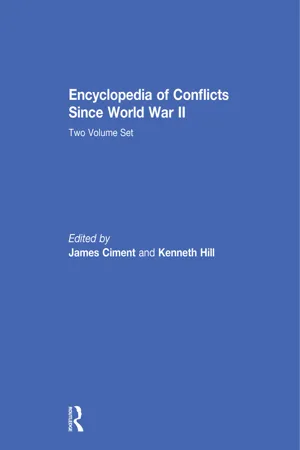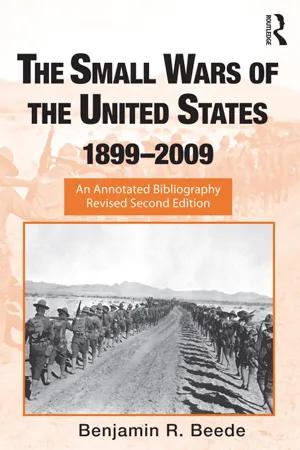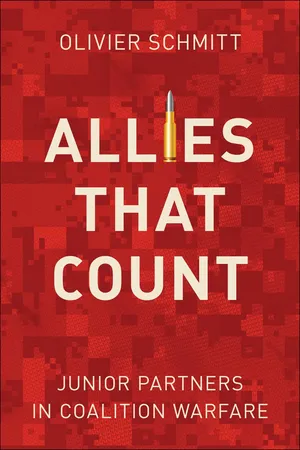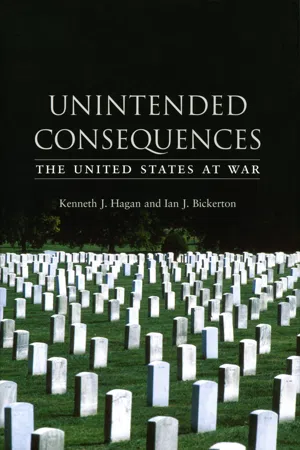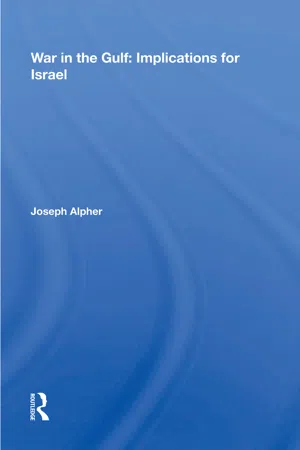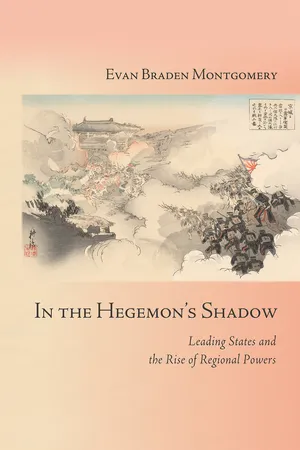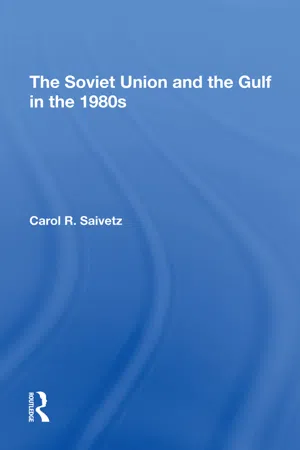History
Gulf War
The Gulf War, also known as the First Gulf War, was a conflict that took place in 1990-1991 between Iraq and a coalition of 35 nations, led by the United States and United Kingdom. The war was triggered by Iraq's invasion of Kuwait and resulted in a swift and decisive victory for the coalition forces, leading to the liberation of Kuwait and significant changes in the regional balance of power.
Written by Perlego with AI-assistance
Related key terms
Related key terms
1 of 4
Related key terms
1 of 3
12 Key excerpts on "Gulf War"
- eBook - ePub
- James Ciment, Kenneth Hill(Authors)
- 2012(Publication Date)
- Routledge(Publisher)
Iraq Gulf War, 1990-1991 TYPE OF CONFLICT: Invasions and border disputes PARTICIPANT: United Nations CoalitionThe Gulf War represents a major turning point in the history of the post-World War II era. By organizing a multinational coalition to oust Iraq from Kuwait—following its August 1990 invasion—the United States demonstrated its unchallenged superpower status in the first major war of the post-cold war era. While the Soviet Union and China stood by, after effectively giving their blessing to the U.S.-led mission, the allied forces, under U.N. aegis, overwhelmed Iraqi forces in a matter of weeks, not only driving them from Kuwait but virtually destroying Baghdad's capacity to make war.The war also represented a major turning point in the history of Middle Eastern relations as well. By arraying most of the Arab countries against Iraq—and persuading Israel to stand aside—the United States asserted itself as the dominant outside power in the region. Moreover, the war left Iraq militarily, politically, and economically crippled—especially after seven years of sanctions imposed during the Iran-Iraq War of 1980-1988—essentially ending its decades-old effort to assume leadership of the Arab world. In the United States, the war's impact was not quite so clear. While President George Bush asserted that the decisive victory over Iraq had ended the so-called Vietnam syndrome in American foreign policy—whereby the American people resisted major U.S. combat intervention overseas—the massive antiwar demonstrations sent a different message.Historical Background
The ultimate causes of the Gulf War go back nearly 300 years. Since the 1500s, the Ottoman Empire had ruled Mesopotamia—modern Iraq—and much of the western littoral of the Persian Gulf. As per imperial tradition, the sultan in Constantinople had ruled these domains by a variety of direct and indirect means. In the more settled and accessible plains of Mesopotamia, Ottoman control was tighter, largely being in the hands of governors appointed by the sultan. In the poorer and more nomadic Persian Gulf littoral, the sultan governed by means of various local sheiks. Since the 1750s, the territory that is now Kuwait was ruled by the al-Sabah dynasty. Still, Kuwait was considered part of the province of Basra, one of three that would eventually come to form Iraq. - eBook - ePub
The Small Wars of the United States, 1899-2009
An Annotated Bibliography
- Benjamin R. Beede(Author)
- 2012(Publication Date)
- Routledge(Publisher)
XXVII
Persian Gulf War, 1990–91
The Persian Gulf War arose from Iraq’s seizure of Kuwait on August 2, 1990, after a period of increasing tension between the two countries. Iraq had long claimed Kuwait as a “lost” province, but Iraq cited additional reasons for the invasion. The dramatic attack aroused condemnation that was almost worldwide. Iraq made numerous political and diplomatic moves to tie its attack on Kuwait to the Arab–Israeli dispute in order to win support for its actions from the Arab countries, but these efforts were largely unsuccessful.The conflict was in three stages. A Coalition of nations was established under United Nations auspices and under United States leadership, which conducted a major military build-up in the Gulf region, primarily in Saudi Arabia. This was Operation Desert Shield, which was intended to protect Saudi Arabia and some smaller Arab oil-producing countries in the area.After protracted negotiations and further political and diplomatic efforts, Iraq was warned to remove its forces from Kuwait by January 15, 1991. Because Iraq did not comply with this demand, Coalition forces began an effort to free Kuwait and later to invade Iraq. This was Operation Desert Storm, which lasted from January 17 to February 28, 1991.The third segment of the Gulf conflict was Operation Provide Comfort I, which was an effort to provide humanitarian aid to Kurds in northern Iraq who had rebelled against the Saddam Hussein regime and to protect the Kurds from Iraqi air attacks by establishing a “no-fly zone” over the Kurdish portion of Iraq. Operation Provide Comfort I was largely a United States effort, although it was based on United Nations resolution 688. The operation lasted from April 6 to July 24, 1991, and it was followed by successive “no-fly zone” stipulations. The Persian Gulf War demonstrated the ability of the United States to build a temporary alliance of great magnitude and the capability to mount and execute a huge military effort. Nevertheless, the war was not as successful as first had seemed to be the case. Despite hopes that the loss of the war would topple Saddam Hussein, he showed he was able to weather not only this crisis but also continuing tensions, including the imposition of severe sanctions by the United Nations. Moreover, Iraqi military forces were not as severely impacted by Coalition military action as had been thought. - eBook - ePub
Allies That Count
Junior Partners in Coalition Warfare
- Olivier Schmitt(Author)
- 2018(Publication Date)
- Georgetown University Press(Publisher)
1 The Gulf Conflict Junior Partners in a Major War The US-led 1991 multinational military intervention to liberate Kuwait from an Iraqi invasion was, on many levels, a defining moment and marked a turning point on the international stage. After the conflict, it was widely believed that the political and military success of the Gulf War would serve as a template for future military interventions. In a sense, the Gulf War opened a decade of the United States’ absolute preeminence on the world stage (the French foreign minister Hubert Védrine coined the term “hyperpower”); it would end with the September 11 attacks and the US military’s involvement in Afghanistan and Iraq, where America would lose money, prestige, and lives. 1 As the first war that live media such as CNN extensively covered, the Gulf War gave the Western public an impression of transparency and a glimpse into the future of Western wars won by surgical strikes and waged with limited risks to coalition forces on the ground. 2 Politically the Soviet Union approved a US-led military intervention and did not use its veto power at the United Nations Security Council. Pundits and policymakers alike thought that this political agreement of the superpowers would open a new era of international cooperation under the UN framework. Yet it also marked the ascendance of the United States over the Soviet Union, which would effectively collapse in December of the same year. 3 The conflict also showed Muslim and Western countries cooperating to defeat a common adversary. In total, thirty-two states officially participated in the Gulf War, and the eclectic coalition comprised countries such as Norway, Hungary, Bangladesh, Morocco, Poland, and South Korea - eBook - ePub
Western Military Interventions After The Cold War
Evaluating the Wars of the West
- Marek Madej, Marek Madej, Marek Madej(Authors)
- 2018(Publication Date)
- Routledge(Publisher)
1 The GulfThe first Western war after the Cold War
Kamila Pronińska1 Strategic context
1.1 The sources of the armed conflict in the Gulf
The Gulf War broke out in the broad strategic context of the end of the Cold War and the changing balance of power in the Middle East. The reduced role of the Soviet Union (USSR) provided the United States (US) with greater possibilities of influencing the Middle East and thus transforming the existing regional order. At the same time, the limited capability of the USSR in providing assistance to the ‘friendly’ regimes significantly upset the balance of power in the Middle East.1 Yet, the West perceived the new security environment as ambiguous, and the US administration had no ‘clear and consistent Middle Eastern policy’.2A highly significant factor in the new strategic context was the policy of the Iraqi regime and its relations with the Arab world. The Iraqi dictator Saddam Hussein openly voiced his concerns regarding the possibility of a new balance of power unfavourable to Arab countries emerging in the region after the erosion of the USSR. Verbalising the concerns of the Arab countries, Saddam also offered an alternative: if these countries worked together and consolidated their resources and financial assets, the US would have to take heed of their positions and interests to a greater extent.3The factors that induced Iraq to invade Kuwait were both of a geopolitical and an economic nature. On the one hand, Iraq never came to terms with the borders of Kuwait and had already challenged its border with Kuwait in 1938. Its territorial claims became even more significant when considerable oil deposits (the Rumaila field) were discovered close to the border. After Kuwait gained independence, Iraq consistently demanded that Kuwait return the territories given it in 1923 and regularly accused Kuwait of ‘illegally exploiting’ the oil and gas deposits in the borderland. On the other hand, Iraq’s financial problems caused by a changed situation in the oil market and by the debts from the time of the Iran–Iraq War (1980–1988) were also a strong impulse for the aggression. In the 1980s, there was a considerable change in the oil market, involving a sudden decrease in oil prices. Kuwait decided to increase output from the contested Rumaila field from August 1988 onwards. The United Arab Emirates (UAE) increased their output as well. By effecting a decrease in oil prices, these actions were detrimental to the indebted Iraqi economy. - eBook - ePub
Unintended Consequences
The United States at War
- Kenneth J. Hagan, Ian J. Bickerton(Authors)
- 2007(Publication Date)
- Reaktion Books(Publisher)
TENTHE WARS AGAINST IRAQ,1991–2007
The whole last century is littered with failures of prediction.Paul Wolfowitz, June 20011The war launched against Iraq in February 2003 was billed as a war of necessity, an effort to make the United States safer following shocking attacks by suicide bombers flying commercial aircraft into the New York World Trade Center and the Pentagon building in Washington, DC , on 11 September 2001, which killed more than 3,000 people. In reality, the war was an extension of – or the completion of – the first Gulf War, ‘Operation Desert Storm’, launched against Iraq by George H. W. Bush on 17 January 1991 to force Iraq’s ruler, Saddam Hussein, to withdraw from his five-month occupation of neighbouring Kuwait.The Gulf War of 1991 was the first war fought by the United States after the collapse of the Soviet Union and the end of the Cold War. The war itself was unexpected, in that the United States was drawn into a situation it had indirectly, inadvertently, helped create. In ways reminiscent of its actions in relation to Korea in 1950, the United States in mid-1990 had conveyed ambiguous messages to the Iraqi regime, which it had formerly supported against Iran, concerning Iraq’s increasingly menacing dispute with neighbouring Kuwait. Confident that the United States would not forcefully respond, 140,000 Iraqi troops and 1,800 tanks invaded an unprepared Kuwait on 2 August 1990 and overran the small Gulf state within two days. Iraq was seeking redress for real and imagined grievances concerning massive Iraqi debts owed to Kuwait accrued during the Iraq–Iran war between 1980 and 1988, Kuwait’s overproduction of oil, and disputes between the two states about sovereignty over local islands. Arab states, the United States, the Soviet Union and many other nations immediately condemned the invasion. - eBook - ePub
The Roots and Consequences of 20th-Century Warfare
Conflicts That Shaped the Modern World
- Spencer C. Tucker(Author)
- 2016(Publication Date)
- ABC-CLIO(Publisher)
Persian Gulf War (1991) CausesThe chief cause of the Persian Gulf War was the Iraqi invasion of and refusal to withdraw from Kuwait. On July 17, 1990, Iraqi president Saddam Hussein, dictator since 1979, threatened military action against Kuwait for its overproduction of oil quotas that had helped drive down the world price of oil. Iraq was heavily in debt as a consequence of the Iran-Iraq War (1980–1988) and wanted the price of oil to be as high as possible. Hussein also sought concessions on the vast sums that Iraq owed to Kuwait for loans during the war. He wanted to secure control of Bubiyan and Warbah Islands to improve Iraqi access to the Persian Gulf and end what he claimed was Kuwaiti slant drilling into the major Iraqi Rumaila oil field. Undergirding all this was Iraq’s long-standing claim that Kuwait was an Iraqi province.In mid-July 1990, American spy satellites detected Iraqi forces massing along the Kuwaiti border. The intent was unknown, but U.S. analysts assumed that it was most likely a show of force by the Iraqis to extract concessions from Kuwait. After all, Kuwait was hardly in a position to resist militarily. U.S. policy was in any case unclear, and Washington had tacitly supported Iraq in its war with Iran, providing intelligence information. However, for some time Washington had been concerned over Iraq’s expanding nuclear industry and its development of chemical and biological weapons, which had been employed in the war against Iran as well as against Kurds within Iraq itself.On July 25 new U.S. ambassador to Iraq April Glaspie, a career diplomat and skilled Arabist, met for the first time with Hussein, who was accompanied by Iraqi deputy prime minister Tariq Aziz. Glaspie delivered mixed messages on behalf of the George H. W. Bush administration that seemed, at least to the Iraqis, to allow Hussein operational freedom in the Persian Gulf. - eBook - ePub
War In The Gulf
Implications For Israel
- Joseph Alpher(Author)
- 2019(Publication Date)
- Routledge(Publisher)
1. The Gulf War — Main Political and Military Developments Shlomo GazitA Crisis Nobody Wanted
The Iraqi occupation of Kuwait, the subsequent political and military steps, and their culmination in Operation Desert Storm carried out by an international coalition under US leadership, resemble a Greek tragedy: each of the actors wanted to halt the slide toward war, yet fate willed otherwise. And it was fate that determined the course of events.Nobody could have surmised that Iraq would steer itself into a collision course with the superpower that stood at the helm of a vast international coalition and was acting on the authority of the UN Security Council. The Iraqi moves that placed Baghdad on that course were a pitiful combination of ignorance, insolence and megalomania. By any standard of logic, they should not have happened. But then, history is full of events nobody would have thought possible.On the eve of the occupation of Kuwait on August 2, 1990, both Iraq and the United States were captives of political conceptions that impeded due consideration, in-depth analysis and a realistic assessment of imminent developments. For Iraq, this is true for the period of crisis as well, and even for the period of military operations.The following analysis will focus on these conceptions and their impact on the political and military steps taken during the crisis and war.Iraq's Political Conceptions
The background to the long-standing conflict around Iraq's refusal to accept Kuwait's separate existence is too well known to bear repeating here. Suffice it to say that Iraq claimed Kuwait as part of the former Ottoman province of Basra, and as an integral section of the geographical unit situated to the southwest of the Shatt al Arab River — Iraq's natural zone of access to the Persian Gulf. In 1990, however, historical argument was more a pretext to justify action than a concrete motive for it. - eBook - ePub
US Foreign Policy in the Middle East
The Roots of Anti-Americanism
- Kylie Baxter, Shahram Akbarzadeh(Authors)
- 2012(Publication Date)
- Routledge(Publisher)
Saddam’s War: The Origins of the Kuwait Conflict and the International Response (London: Faber and Faber).Miller, Judith and Mylroie, Laurie (1990) Saddam Hussein and the Crisis in the Gulf (New York: Times Books).O’Balance, Edgar (1988) The Gulf War (London: Brassey’s Defence Publishers).Schofield, Richard N. (1993) Kuwait and Iraq: Historical Claims and Territorial Disputes, second edition (London: Royal Institute of International Affairs).Sciolino, Elaine (1991) The Outlaw State: Saddam Hussein’s Quest for Power and the Gulf Crisis (New York: Wiley).Short, Martin and McDermott, Anthony (1981) The Kurds, fourth revised edition (London: Minority Rights Group).Tarock, Adam (1988) The Superpowers’ Involvement in the Iran–Iraq War (Commack, NY: Nova Science).United Nations Department of Public Information (1994) Resolutions of the United Nations Security Council and Statements by Its President concerning the Situation between Iraq and Kuwait (2 August 1990–16 November 1994) (New York: United Nations Department of Public Information).United Nations Department of Public Information (1996) The United Nations and the Iraq–Kuwait Conflict, 1990–1996, with an Introduction by Boutros-Boutros Ghali (New York: United Nations Department of Public Information).Vali, Abbas (ed.) (2003) Essays on the Origins of Kurdish Nationalism (Costa Mesa, CA: Mazda).SUGGESTED STUDY QUESTIONS1 What was the rationale for, and impact of, superpower involvement in the 1980–88 Iran–Iraq War? 2 What were the major outcomes of Operation Desert Storm? 3 In what ways can the 1991 Gulf War be considered a turning point in Middle Eastern politics? 4 Why did the United States leave Saddam Hussein in power after the 1991 conflict? - eBook - ePub
- Ken Matthews(Author)
- 2003(Publication Date)
- Routledge(Publisher)
Two major thresholds can be noted in this trend to increasing coercive pressure (see Chapter 4 and Fig. 4.3 on crisis phases and thresholds). One was the change in US policy from one of defence to one of offence with the decision massively to enhance the US military force in the Gulf region; as noted above this signalled the transition from a policy of defending Saudi Arabia to one of liberating Kuwait. The other was the UN resolution authorising all necessary means and the setting of the 15 January deadline. This put war ‘formally’ on the agenda, as it were (Table 9.3).COALITION MILITARY STRATEGY
Table 9.3 Key stages in the Gulf conflict 1990–1The authority of Security Council Resolution 678 provided for the implementation of the provisions of Resolution 660 of 2 August 1990—that is, to secure the withdrawal of Iraqi forces ‘to positions in which they were located on 1 August 1990’—and ‘all subsequent relevant resolutions and to restore international peace and security in the area’.Note: Structurally the war can be seen as a whole—from the initial Iraqi invasion of Kuwait, through the brief Kuwaiti resistance, the retreat of the Kuwait army, the long period of diplomatic activity and UN military mobilisation characterised by the breaching of successive ‘thresholds’ (see Chapter 4 ), to the Coalition offensive and Iraqi defeat.These provisions were essentially incompatible with each other and one of the questions that arose in translating the legal authority into military terms was to what extent the provisions of restoring ‘the sovereignty, independence and territorial integrity of Kuwait’ and of ‘restoring international peace and security in the area’ could reasonably be said to have been achieved by merely securing the withdrawal of Iraqi forces ‘to positions in which they were located on 1 August 1990’. Merely relocating a half million Iraqis a few kilometres to the north of the Iraq-Kuwait border would neither secure the future integrity of Kuwait (if they could simply move back south again when conditions were propitious for them) nor, while this military capability remained, re-establish peace and security in the region. So the image of a military operation limited to a northward thrust by Coalition troops from Saudi Arabia into Kuwait pushing the Iraqi occupation troops to retreat back into southern Iraq was never a realistic picture of what would be necessary to implement the UN resolutions. Firstly the restoration of peace and security in the region could be taken to entail a substantial diminution of Iraq’s military ability to constitute a threat to any of its neighbours; and secondly even a mere relocation of Iraqi troops would require a military operation much more extensive than the one envisaged by this sort of picture. - eBook - ePub
Cornell Studies in Security Affairs
Leading States and the Rise of Regional Powers
- Evan Braden Montgomery(Author)
- 2016(Publication Date)
- Cornell University Press(Publisher)
In principle, this strategy made sense. In practice, however, it overestimated the effectiveness of engagement and underestimated Iraq’s willingness to start another war so soon after the last one. Despite the administration’s early hope that Iraq would moderate its behavior, as well as its expectation that Baghdad would not engage in overly provocative or aggressive actions until it had recovered more fully, Iraqi–American relations experienced a sharp downturn in 1990. This deterioration can be traced back to a number of developments, including Saddam’s increasingly hostile rhetoric toward Israel and his ongoing efforts to procure technologies useful for building nuclear weapons. Meanwhile, growing tensions between Arab nations also became a source of concern, in particular Iraq’s worsening relationship with Kuwait. Baghdad had long coveted the tiny Gulf kingdom along its border, which required the assistance of British troops to rebuff an Iraqi claim in 1961. For the most part, however, this dispute had been dormant while the threat from Iran loomed over the entire region. Now it was taking center stage once again. In the aftermath of the war, Iraq began to accuse Kuwait of stealing its oil and ignoring OPEC production limits to fill its coffers. Whether or not the accusations were true, Kuwait did not do itself any favors by demanding that Iraq repay loans it had received during the conflict, which fueled a sense of aggrievement in Baghdad that it had shielded the area from the Iranian threat at great cost but had received little in the way of gratitude. For its part, Washington monitored the unfolding situation, pressed Iraq to pursue a diplomatic solution, but refrained from any direct involvement. In other words, it hoped that the problem would simply go away.This was a miscalculation. Tensions in the Gulf increased sharply during the summer of 1990. Beginning in July, Iraqi forces began to mobilize in large numbers along the Kuwaiti border. Most observers inside and outside the region assumed this was merely an act of saber rattling, including close U.S. allies such as Egypt, which reassured Washington that a war was unlikely. On August 2, however, the dispute between Iraq and Kuwait came to a head. Iraqi units entered the country and quickly overran its meager defenses, throwing the region into crisis once again. This time, however, outside actors were far less willing to sit back and watch than they had been a decade earlier, particularly the United States. Initially, policymakers in Washington were caught off guard by the invasion. Their first reaction, therefore, was to debate the stakes of the crisis as well as how far they should go to assist Kuwait. They soon reached a consensus, however, and implemented their response: condemning the action publicly; imposing unilateral economic sanctions against Iraq; mobilizing support at the United Nations for multilateral economic sanctions; and deploying U.S. military forces to Saudi Arabia in defense of the desert kingdom, which would have been an extremely valuable and extremely vulnerable target if Saddam had continued his advance. As President Bush declared shortly after he learned of the invasion, Baghdad’s aggrandizement “will not stand.”79From the very start of the crisis, U.S. officials were doubtful that diplomatic pressure and economic coercion would be sufficient to end Iraq’s occupation of Kuwait. They recognized, therefore, that a larger conflict might be on the horizon. In fact, President Bush came to the realization that war was the likely outcome almost immediately, and most of his chief advisors reached a similar conclusion soon afterward.80 - eBook - ePub
Japan and UN Peacekeeping
New Pressures and New Responses
- Hugo Dobson(Author)
- 2003(Publication Date)
- Routledge(Publisher)
New York Times, 4 August 1990). The permanent occupation of Kuwait and the creation of the nineteenth province of the Iraqi state were announced duly. The reaction of the UN and the international community is examined in the next section, but faced with almost universal condemnation and the build-up of a MNF in Saudi Arabia against the Iraqi invasion under the Desert Shield operation, Saddam attempted to link the conflict with Kuwait to the general situation in the Middle East by agreeing to withdraw from Kuwait if Israel agreed to withdraw from the Golan Heights, the West Bank and the Gaza Strip. Iraqi forces were also strengthened in Kuwait, seemingly with the aim of either consolidating the occupation of Kuwait or continuing Iraqi aggression into Saudi Arabia. It was at this stage in the conflict that Saddam began to move foreign nationals in Kuwait and Iraq to military installations as ‘human shields’ against any military strikes on these bases by the MNF. Eventually the hostage incident passed with their release before Christmas 1990 for reasons that remain unclear. Nevertheless, the Iraqi military build-up in Kuwait continued to frustrate any diplomatic attempt (investigated later) to resolve the dispute peacefully before the UN deadline for Iraq's withdrawal of 15 January 1991.The Second Gulf War began with the passing of this deadline. The initial stages of the conflict were characterised by the air campaign designed to destroy Iraqi air defences and command and control structures with a massive demonstration of force (in the first twenty-four hours of the air campaign over 1000 sorties were made) and the objectives of preventing Iraqi interference in the MNF's air operations, grinding down Iraqi air defences in Kuwait, and a sustained attack on the Iraqi field army were largely achieved with minimal casualties in preparation for the ground campaign. Saddam's policy in reaction to the air war included the use of Scud-B missile attacks on Saudi Arabia and Israel, a threat which was addressed with the use of Patriot missiles but would continue to be a military and diplomatic issue until Iraq's defeat.As the air campaign ended, the Allied ground offensive began on 24 February 1991, postponed by three days due to eleventh-hour diplomatic attempts to broker a deal. The ground offensive, sometimes called the 100-hour war, was a 1990s version of the Schlieffen Plan of the First World War. The MNF shifted to the West, attacked the Iraqi divisions in Kuwait from the rear and western flanks in a swift encircling movement. The strategy was successful in ejecting Iraqi troops from Kuwait and minimised Allied casualties. On 27 February 1991 the multinational troops liberated Kuwait City, but operations were called to a conclusion only after retreating Iraqi troops were bombed back to Iraq in the north. Discussions began on 3 March 1991 between Iraqi and Allied military leaders at the Safwan airstrip with the aim of agreeing a cease-fire. There followed a political process that culminated in a UN-mandated cease-fire in mid-April. At the same time the process of policing and clearing up the polluted battlefield began. - eBook - ePub
- Carol R Saivetz(Author)
- 2019(Publication Date)
- Routledge(Publisher)
2The Iran-Iraq WarOrigins of the Gulf War
The hostility between Gulf neighbors Iran and Iraq which culminated in war has its roots in the imperial past of the region. The dispute over the Shatt-al-Arab may be traced to the Persian-Ottoman tug-ofwar which developed in the sixteenth century. Since then the territorial dispute has resulted in all-out wars and periods of short-lived peace. The border area—often times including Basra—was controlled by turns by the Persians and the Turks. In the nineteenth century, the British and Tsarist empires inserted their power into the area. The ensuing British-Russian “great game” necessitated controlling the rivalry between the two Mideast empires: Indeed, in 1843, Russia and Great Britain established a Turko-Persian commission to settle border questions.1 The resulting treaty (the second treaty of Erzerum), which was more favorable to the Persians, temporarily demarcated the boundary; however, ethnic disputes continued to flare along the line.Then, again in 1913, a new series of agreements established the international boundary at the low water mark of the Iranian shore line and further delineated the whole of the Turko-Persian border. This pre-World War I settlement was clearly more favorable to the Ottomans. Persia was required to relinquish certain territories along the Shatt and international access was permitted to the port of Khorramshahr. The Iranians, claiming that the collection of revenues by Iraq from ships on the Shatt violated the 1913 agreement, sought to reverse the situation.2With the end of World War I and the collapse of the Ottoman Empire, Iraq emerged as an independent state—albeit under British control. Iran, seeking to gain concessions from Iraq, withheld recognition of the monarchy in Baghdad until 1929. When King Faisal I visited Teheran in 1932, the Iranians requested a border rectification on the Shatt. Following unsuccessful League of Nations participation, Iran and Iraq undertook bilateral negotiations. These resulted in a 1937 treaty which netted the Iranians a territorial gain opposite Abadan. Nonetheless, Baghdad continued to control most of the Shatt-al-Arab.
Index pages curate the most relevant extracts from our library of academic textbooks. They’ve been created using an in-house natural language model (NLM), each adding context and meaning to key research topics.
Explore more topic indexes
Explore more topic indexes
1 of 6
Explore more topic indexes
1 of 4
